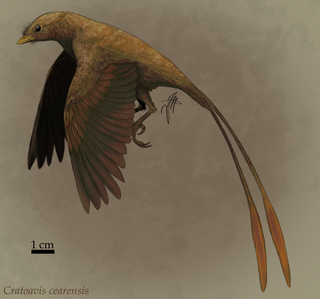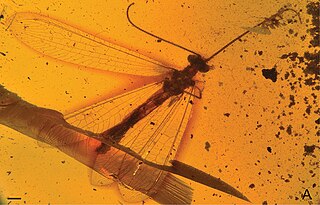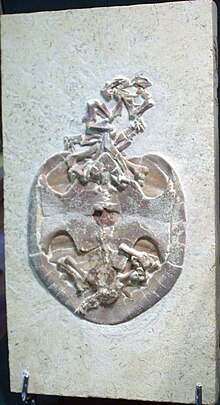
The Crato Formation is a geologic formation of Early Cretaceous (Aptian) age in northeastern Brazil's Araripe Basin. It is an important Lagerstätte for palaeontologists. The strata were laid down mostly during the Aptian age, about 113 million years ago. It thought to have been deposited in a semi-arid lacustrine wetland environment.

Crato is a city of 130,000 inhabitants on the banks of the river Granjeiro in the south of the state of Ceará, in the northeast of Brazil. It was founded on June 21, 1764 by the Capuchin friar Carlos Maria de Ferrara. Originally it was a small village in which the population were principally native Kariris, it gained official status as a city on October 17, 1817.

The Romualdo Formation is a geologic Konservat-Lagerstätte in northeastern Brazil's Araripe Basin where the states of Pernambuco, Piauí and Ceará come together. The geological formation, previously designated as the Romualdo Member of the Santana Formation, named after the village of Santana do Cariri, lies at the base of the Araripe Plateau. It was discovered by Johann Baptist von Spix in 1819. The strata were deposited during the Aptian stage of the Early Cretaceous in a lacustrine rift basin with shallow marine incursions of the proto-Atlantic. At that time, the South Atlantic was opening up in a long narrow shallow sea.

Tapejara is a genus of Brazilian pterosaur from the Cretaceous Period. Tapejara crests consisted of a semicircular crest over the snout, and a bony prong which extended back behind the head. It was a small pterosaur, with a wingspan of approximately 1.23–1.3 metres (4.0–4.3 ft).
Brasileodactylus a genus of pterosaur from the Aptian-age lower Santana formation of Chapada do Araripe, Ceará, Brazil.
Caririemys is an extinct genus of side-necked turtles, belonging to the Pelomedusoides of the family Euraxemydidae. The type species is C. violetae. A single fossil of an individual was found in the Santana Formation in Brazil, an 80-million-year-old Late Cretaceous deposit that has so far preserved other fossil reptiles such as dinosaurs and crocodilians.

Cearachelys is an extinct genus of pleurodiran turtle which existed some 110 million years ago. The genus is monotypic, with only type species Cearachelys placidoi known.
The Bauru Group is a geological group of the Bauru Sub-basin, Paraná Basin in Minas Gerais, São Paulo, General Salgado, Itapecuru-Mirim, Mato Grosso, Brazil whose strata date back to the Late Cretaceous. Dinosaur remains are among the fossils that have been recovered from the formation.
The Jaibaras River is a river of Ceará state in eastern Brazil.

Barbalha is a municipality in the state of Ceará in the Northeast region of Brazil. Barbalha covers 569.5 km2 (219.9 sq mi), and has a population of 61,228 with a population density of 100 inhabitants per square kilometer. It is located at the south of the state, 575 km (357 mi) from the state capital of Fortaleza. The eastern part of the Araripe-Apodi National Forest, established in 1946, is located in Barbalha. The city sits at the foot of the Chapada do Araripe, a large plateau on the border of Ceará and Pernambuco.
Beurlenia is an extinct genus of shrimp containing the species Beurlenia araripensis. It is named after the German palaeontologist Karl Beurlen (1901–1985). Fossils of the shrimp were found in the Crato Formation of the Araripe Basin of northeastern Brazil. A study on the anatomy and morphological variation in Beurlenia araripensis, based on data from fossil samples from the Crato Formation (Brazil), was published by Barros et al. (2021).
Eurycephalella is an extinct genus of frogs which existed in what is now Brazil during the Early Cretaceous (Aptian). It was named by Ana M. Báez, Geraldo J.B. Moura and Raúl O. Gómez in 2009, and the type species is Eurycephalella alcinae.

Susisuchus is an extinct genus of neosuchian mesoeucrocodylian crocodyliform from the Early Cretaceous of Brazil. Fossils have been found from the Nova Olinda Member of the Aptian-age Crato Formation in the Araripe and Lima Campos Basins of northeastern Brazil. Named in 2003, Susisuchus is the sole member of the family Susisuchidae, and is closely related to the clade Eusuchia, which includes living crocodilians. The type species is S. anatoceps, known from a single partial articulated skeleton that preserves some soft tissue. A second species, S. jaguaribensis, was named in 2009 from fragmentary remains.

The Araripe Basin is a rift basin covering about 8,000 square kilometres (3,100 sq mi), in Ceará, Piauí and Pernambuco states of northeastern Brazil. It is bounded by the Patos and Pernambuco lineaments, and is situated east of the Parnaíba Basin, southwest of the Rio do Peixe Basin and northwest of the Tucano and Jatobá Basins.

Cratoavis is a genus of enantiornithines. The type and only currently described species is C. cearensis, from the Early Cretaceous of Araripe Basin, Ceará, Brazil. The fossil, an articulated skeleton with feathers attached to the wings and surrounding the body, extends considerably the temporal record of the group at South America.

The Santana Group is a geologic group, formerly included as the middle part of the Araripe Group, in the Araripe Basin of northeastern Brazil. The group comprises the Crato, Ipubi and Romualdo Formations and is dated to the Aptian to Albian stages of the Early Cretaceous. The formations of the group were deposited in a lacustrine to subtidal shallow marine environment in the Araripe rift basin.

The Ipubi Formation is the middle geological formation of the Santana Group, the middle part of the Araripe Group, in the Araripe Basin of northeastern Brazil. The formation is dated to the Aptian to Albian stages of the Early Cretaceous, unconformably overlying the Crato Formation and unconformably overlain by the Romualdo Formation, formerly known as the Romualdo Member of the Santana Formation. The averaging 15 metres (49 ft) thick Ipubi Formation comprises shales and sandstones in the lower section and evaporites in the upper part of the formation, deposited in a transgressive to highstand lacustrine environment in the Araripe rift basin.

The Missão Velha Formation is a late Jurassic geologic formation in northeastern Brazil's Araripe Basin where the states of Pernambuco, Piauí and Ceará come together. The formation is the middle stratigraphic unit of the Vale do Carirí Group, overlying the Brejo Santo Formation and overlain by the Abaiara Formation.

Babinskaiidae is an extinct family of neuropterans known from the Cretaceous period. They are part of the superfamily Myrmeleontoidea. Their distinguishing characters include: "long filiform antennae, narrowly elongated wings, with features such as trichosors, and presectorial cross veins present in both wings, and absence of forewing oblique vein". They are considered transitional between Nymphidae and more derived myrmeleontodoids, such as antlions.

Araripelepidotes is a genus of ginglymodian fish.












